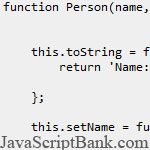









 L'encapsulation est une technique tr
L'encapsulation est une technique tr
For real encapsulation, the following criteria need to be met:
To fulfill these criteria we're going to need to create a small abstraction that will enable us to define our constructor, its methods, and its properties in a plain object, which will then be processed to produce the required constructor and prototype.
In accordance with convention, this abstraction will be named Class. This is how it will typically work:
var Person = new Class({ _name: 'Blank', _age: 0, init: function(name, age) { this.name = name; this.age = age; }, toString: function() { return 'Name: ' + this.name + ', Age: ' + this.age; }, setAge: function(age) { this.age = age; }, setName: function(name) { this.name = name; } });
The underscore prefix tells Class that we want those properties to be private. Privacy is achieved by retaining a truly private (in a closure) privates
array, each item within the array represents the private properties of
each instance. This will be clearer once you've seen the source (below).
Class looks for an init method to use as the constructor.
Here's the source for Class, excluding the function:
function Class(o){ var id = 0, privates = {}, instancePrivates = [], constructor = function(){ this.__id = id++; // Copy privates over to new privates obj, // just for this instance. instancePrivates[this.__id] = { privates: merge({}, privates), constructor: this }; if (this.init) { this.init.apply(this, arguments); } return this; }, m; function method(name, fn) { constructor.prototype[name] = function() { var i, ret, thisPrivates = instancePrivates[this.__id] || {}; // Check constructor if (thisPrivates.constructor !== this) { // this.__id has been changed, exit. return; } thisPrivates = thisPrivates.privates; for (i in thisPrivates) { this[i] = thisPrivates[i]; } ret = fn.apply(this, arguments); for (i in thisPrivates) { thisPrivates[i] = this[i]; delete this[i]; } return ret; }; }; for (m in o) { // Test for privates if ( /^_/.test(m) ) { privates[m.replace(/^_/, '')] = o[m]; } else { method(m, o[m]); } } return constructor; }
There are cleaner ways of implementing this, but just for readability's sake, we're identifying each instance with a simple __id property. Yes, this can be manipulated from the outside, but doing so would result in the methods not running.
It has some constraints, but it does provide us with encapsulation:
var Person = new Class({ _name: 'Blank', _age: 0, init: function(name, age) { this.name = name; this.age = age; }, toString: function() { return 'Name: ' + this.name + ', Age: ' + this.age; }, setAge: function(age) { this.age = age; }, setName: function(name) { this.name = name; } }); // Testing: var jimmy = new Person('Jim', 88); jimmy._name; // undefined jimmy.name; // undefined jimmy.toString(); // => "Name: Jim, Age: 88" jimmy.setName('Jimmy'); jimmy.toString(); // => "Name: Jimmy, Age: 88" jimmy.setAge(54); jimmy.toString(); // => "Name: Jimmy, Age: 54" jimmy._age; // undefined jimmy.age; // undefined
You can also have private methods, e.g.
var Box = new Class({ _width: 0, _height: 0, init: function(width, height) { this.width = width; this.height = height; }, info: function() { return 'Width: ' + this.width + ',\nHeight: ' + this.height + ',\nArea: ' + this.calcArea(); }, _calcArea: function() { return this.width * this.height; } }); var myBox = new Box(100, 100); myBox.calcArea; // undefined myBox._calcArea; // undefined myBox.info(); // => "Width: 100,\nHeight: 100,\nArea: 10000"
The method I used to achieve full encapsulation, while quite novel, isn't going to be appropriate in all situations. The population and clearing of private variables has to happen on every method call, and so will likely cause a significant overhead in some applications.
That said, I don't think the overhead will be all that significant, unless you've got a crazy amount of private properties/methods.
I hope this post has given you some insight into how you can achieve encapsulation and information-hiding in JavaScript.